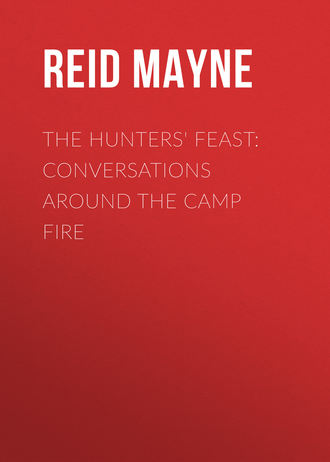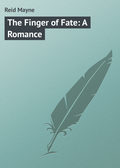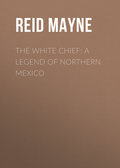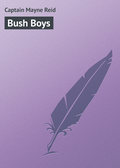
Майн Рид
The Hunters' Feast: Conversations Around the Camp Fire
Chapter Eighteen.
A Chacu of Vicuñas
“Well, upon the morrow,” continued the Englishman, “we had our guanaco hunt, and killed several of the herd we had seen on the previous day. There was nothing particular in regard to our mode of hunting – farther than to use all our cunning in getting within shot, and then letting fly at them.
“It is not so easy getting near the guanaco. He is among the shyest game I have ever hunted, and his position is usually so far above that of the hunter, that he commands at all times a view of the movements of the latter. The over-hanging rocks, however, help one a little, and by diligent creeping he is sometimes approached. It requires a dead shot to bring him down, for, if only wounded, he will scale the cliffs, and make off – perhaps to die in some inaccessible haunt.
“While sojourning with my hunter-friend, I heard of a singular method practised by the Indians, of capturing the vicuña in large numbers. This was called the ‘chacu.’
“Of course I became very desirous of witnessing a ‘chacu,’ and the hunter promised to gratify me. It was now the season of the year for such expeditions, and one was to come off in a few days. It was the annual hunt got up by the tribe to which my host belonged; and, of course, he, as a practised and professional hunter, was to bear a distinguished part in the ceremony.
“The day before the expedition was to set out, we repaired to the village of the tribe – a collection of rude huts, straggling along the bottom of one of the deep clefts or valleys of the Cordilleras. This village lay several thousand feet below the level of the Puna plains, and was therefore in a much warmer climate. In fact, the sugar-cane and yucca plant (Jatropha mainhot) were both seen growing in the gardens of the villagers, and Indian corn flourished in the fields.
“The inhabitants were ‘Indios mansos’ (civilised Indians). They attended part of the year to agriculture, although the greater part of it was spent in idleness, amusements, or hunting. They had been converted – that is nominally – to Christianity; and a church with its cross was a prominent feature of the village.
“The curé, or priest, was the only white man resident in the place, and he was white only by comparison. Though of pure Spanish blood, he would have passed for a ‘coloured old gentleman’ in any part of Europe or the States.
“My companion introduced me to the padre, and I was at once received upon terms of intimacy. To my surprise I learnt that he was to accompany the chacu – in fact to take a leading part in it. He seemed to be as much interested in the success of the hunt as any of them – more so, perhaps, and with good reason too. I afterwards learnt why. The produce of the annual hunt was part of the padre’s income. By an established law, the skins of the vicuñas were the property of the church, and these, being worth on the spot at least a dollar a-piece, formed no despicable tithe. After hearing this I was at no loss to understand the padre’s enthusiasm about the chacu. All the day before he had been bustling about among his parishioners, aiding them with his counsel, and assisting them in their preparations. I shared the padre’s dwelling, the best in the village; his supper too – a stewed fowl, killed for the occasion, and rendered fiery hot with ‘aji,’ or capsicum. This was washed down with ‘chica,’ and afterwards the padre and I indulged in a cigarette and a chat.
“He was a genuine specimen of the South-American missionary priest; rather more scrupulous about getting his dues than about the moral welfare of his flock; fat, somewhat greasy, fond of a good dinner, a glass of ‘Yea’ brandy, and a cigarette. Nevertheless, his rule was patriarchal in a high degree, and he was a favourite with the simple people among whom he dwelt.
“Morning came, and the expedition set forth; not, however, until a grand mass had been celebrated in the church, and prayers offered up for the success of the hunt. The cavalcade then got under weigh, and commenced winding up the rugged path that led toward the ‘Altos,’ or Puna heights. We travelled in a different direction from that in which my companion and I had come.
“The expedition itself was a picturesque affair. There were horses, mules, and llamas, men, women, children, and dogs; in fact, almost every living thing in the village had turned out. A chacu is no common occasion – no one day affair. It was to be an affair of weeks. There were rude tents carried along; blankets and cooking utensils; and the presence of the women was as necessary as any part of the expedition. Their office would be to do the cooking, and keep the camp in order! as well as to assist in the hunt.
“Strung out in admirable confusion, we climbed up the mountain – a picturesque train – the men swinging along in their coloured ponchos of llama wool, and the women dressed in bright mantas of ‘bayeta’ (a coarse cloth, of native manufacture). I noticed several mules and llamas packed with loads of a curious character. Some carried large bundles of rags – others were loaded with coils of rope – while several were ‘freighted’ with short poles, tied in bunches. I had observed these cargoes being prepared before leaving the village, and could not divine the use of them. That would no doubt be explained when we had reached the scene of the chacu, and I forbore to trouble my companions with any interrogatories, as I had enough to do to guide my horse along the slippery path we were travelling.
“About a mile from the village there was a sudden halt. I inquired the cause.
“‘The huaro,’ was the reply.
“I knew the huaro to be the name of a peculiar kind of bridge, and I learnt that one was here to be crossed. I rode forward, and found myself in front of the huaro. A singular structure it was. I could scarcely believe in the practicability of our getting over it. The padre, however, assured me it was a good one, and we should all be on the other side in a couple of hours!
“I at first felt inclined to treat this piece of information as a joke: but it proved that the priest was in earnest. It was full two hours before we were all crossed with our bag and baggage.
“The huaro was nothing more than a thick, rope stretched across the chasm, and made fast at both ends. On this rope was a strong piece of wood, bent into the shape of the letter U, and fastened to a roller which rested upon the rope, and moved along it when pulled by a cord from either side. There were two cords, or ropes, attached to the roller, one leading to each side of the chasm, and their object was to drag the passenger across: of course, only one of us could be carried over at a time. No wonder we were so long in making the crossing, when there were over one hundred in all, with numerous articles of baggage.
“I shall never forget the sensations I experienced in making the passage of the huaro. I had felt giddy enough in going over the ‘soga’ bridges and ‘barbacoas’ common throughout Peru, but the passage of the huaro is really a gymnastic feat of no easy accomplishment. I was first tied, back downwards, with my back resting in the concavity of the bent wood; my legs were then crossed over the main rope – the bridge itself – with nothing to hold them there farther than my own muscular exertion. With my hands I clutched the vertical side of the wooden yoke, and was told to keep my head in as upright a position as possible. Without farther ado I felt myself jerked out until I hung in empty air over a chasm that opened at least two hundred feet beneath, and through the bottom of which a white torrent was foaming over black rocks! My ankles slipped along the rope, but the sensation was so strange, that I felt several times on the point of letting them drop off. In that case my situation would have been still more painful, as I should have depended mainly on my arms for support. Indeed, I held on tightly with both hands, as I fancied that the cord with which I had been tied to the yoke would every minute give way.
“After a good deal of jerking and hauling, I found myself on the opposite side, and once more on my feet!
“I was almost repaid for the fright I had gone through, by seeing the great fat padre pulled over. It was certainly a ludicrous sight, and I laughed the more, as I fancied the old fellow had taken occasion to laugh at me. He took it all in good part, however, telling me that it caused him no fear, as he had long been accustomed to those kind of bridges.
“This slow and laborious method of crossing streams is not uncommon in many parts of the Andes. It occurs in retired and thinly-populated districts, where there is no means for building bridges of regular construction. Of course, the traveller himself only can be got over by the huaro. His horse, mule, or llamas must swim the stream, and in many instances these are carried off by the rapid current, or dashed against the rocks, and killed.
“The whole cavallada of the expedition got safely over, and in a short while we were all en route, once more climbing up toward the ‘altos.’ I asked my companion why we could not have got over the stream at some other point, and thus have saved the time and labour. The answer was, that it would have cost us a twenty miles’ journey to have reached a point no nearer our destination than the other end of the huaro rope! No wonder such pains had been taken to ferry the party across.
“We reached the heights late in the evening. The hunt would not begin until the next day.
“That evening was spent in putting up tents, and getting everything in order about the camp. The tent of the padre was conspicuous – it was the largest, and I was invited to share it with him. The horses and other animals were picketted or hoppled upon the plain, which was covered with a short brown grass.
“The air was chill – cold, in fact – we were nearly three miles above ocean level. The women and youths employed themselves in collecting taquia to make fires. There was plenty of this, for the plain where we had halted was a pasture of large flocks of llamas and horned cattle. It was not there we expected to fall in with the vicuñas. A string of ‘altos,’ still farther on were their favourite haunts. Our first camp was sufficiently convenient to begin the hunt. It would be moved farther on when the plains in its neighbourhood had been hunted, and the game should grow scarce.
“Morning arrived; but before daybreak, a large party had set off, taking with them the ropes, poles, and bundles of rags I have already noticed. The women and boys accompanied this party. Their destination was a large table plain, contiguous to that on which we had encamped.
“An hour afterwards the rest of the party set forth – most of them mounted one way or other. These were the real hunters, or ‘drivers.’ Along with them went the dogs – the whole canine population of the village. I should have preferred riding with this party, but the padre took me along with himself, promising to guide me to a spot where I should get the best view of the chacu. He and I rode forward alone.
“In half an hour we reached the plain where the first party had gone. They were all at work as we came up – scattered over the plain – and I now saw the use that was to be made of the ropes and rags. With them a pound, or ‘corral,’ was in process of construction. Part of it was already finished, and I perceived that it was to be of a circular shape. The poles, or stakes, were driven into the ground in a curving line at the distance of about a rod from each other. When thus driven, each stake stood four feet high, and from the top of one to the other, ropes were ranged and tied, thus making the inclosure complete. Along these ropes were knotted the rags and strips of cotton, so as to hang nearly to the ground, or flutter in the wind; and this slight semblance of a fence was continued over the plain in a circumference of nearly three miles in length. One side, for a distance of several hundred yards, was left unfinished, and this was the entrance to the corral. Of course, this was in the direction from which the drove was to come.
“As soon as the inclosure was ready, those engaged upon it withdrew in two parties to the opposite flanks, and then deployed off in diverging lines, so as to form a sort of funnel, at least two miles in width. In this position they remained to await the result of the drive, most of them squatting down to rest themselves.
“Meanwhile the drive was proceeding, although the hunters engaged in it were at a great distance – scarcely seen from our position. They, too, had gone out in two parties, taking opposite directions, and skirting the hills that surrounded the plain. Their circuit could not have been less than a dozen miles; and, as soon as fairly round, they deployed themselves into a long arc, with its concavity towards the rope corral. Then, facing inward, the forward movement commenced. Whatever animals chanced to be feeding between them and the inclosure were almost certain of being driven into it.
“The padre had led me to an elevated position among the rocks. It commanded a view of the rope circle; but we were a long while waiting before the drivers came in sight. At length we descried the line of mounted men far off upon the plain, and, on closely scrutinising the ground between them and us, we could distinguish several reddish forms gliding about: these were the vicuñas. There appeared to be several bands of them, as we saw some at different points. They were crossing and recrossing the line of the drive, evidently startled, and not knowing in what direction to run. Every now and then a herd, led by its old male, could be seen shooting in a straight line – then suddenly making a halt – and the next minute sweeping off in a contrary direction. Their beautiful orange-red flanks, glistening in the sun, enabled us to mark them at a great distance.
“The drivers came nearer and nearer, until we could distinguish the forms of the horsemen as they rose over the swells of the plain. We could now hear their shouts – the winding of their ox-horns, and even the yelping of their dogs. But what most gratified my companion was to see that several herds of vicuñas were bounding backwards and forwards in front of the advancing line.
“‘Mira!’ he cried exultingly, ‘mira! Señor, one, two, three, four – four herds, and large ones – ah! Carrambo! Jesus!’ continued he, suddenly changing tone, ‘carrambo! esos malditos guanacos!’ (those cursed guanacos). I looked as he was pointing. I noticed a small band of guanacos springing over the plain. I could easily distinguish them from the vicuñas by their being larger and less graceful in their motions, but more particularly by the duller hue of brownish red. But what was there in their presence to draw down the maledictions of the padre, which he continued to lavish upon them most unsparingly? I put the question.
“‘Ah! Señor,’ he answered with a sigh, ‘these guanacos will spoil all – they will ruin the hunt. Caspita!’
“‘How? in what manner, mio padre?’ I asked in my innocence, thinking that a fine herd of guanacos would be inclosed along with their cousins, and that ‘all were fish,’ etcetera.
“‘Ah!’ exclaimed the padre, ‘these guanacos are hereticos– reckless brutes, they pay no regard to the ropes – they will break through and let the others escape —santissima virgen! what is to be done?’
“Nothing could be done except leave things to take their course, for in a few minutes the horsemen were seen advancing, until their line closed upon the funnel formed by the others. The vicuñas, in several troops, now rushed wildly from side to side, turning sharply as they approached the figures of the men and women, and running in the opposite direction. There were some fifty or sixty in all, and at length they got together in a single but confused clump. The guanacos, eight or ten in number, became mixed up with them, and after several quarterings, the whole flock, led by one that thought it had discovered the way of escape, struck off into a gallop, and dashed into the inclosure.
“The hunters, who were afoot with the women, now rushed to the entrance, and in a short while new stakes were driven in, ropes tied upon them, rags attached, and the circle of the chacu was complete.
“The mounted hunters at the same time had galloped around the outside, and flinging themselves from their horses, took their stations, at intervals from each other. Each now prepared his ‘holas,’ ready to advance and commence the work of death, as soon as the corral should be fairly surrounded by the women and boys who acted as assistants.
“The hunters now advanced towards the centre, swinging their bolas, and shouting to one another to direct the attack. The frightened vicuñas rushed from side to side, everywhere headed by an Indian. Now they broke into confused masses and ran in different directions – now they united again and swept in graceful curves over the plain. Everywhere the bolas whizzed through the air, and soon the turf was strewed with forms sprawling and kicking. A strange picture was presented. Here a hunter stood with the leaden balls whirling around his head – there another rushed forward upon a vicuña hoppled and falling – a third bent over one that was already down, anon he brandished a bleeding knife, and then, releasing the thong from the limbs of his victim, again swung his bolas in the air, and rushed forward in the chase.
“An incident occurred near the beginning of the mêlée, which was very gratifying to my companion the padre, and at once restored the equanimity of his temper. The herd of guanacos succeeded in making their escape, and without compromising the success of the hunt. This, however, was brought about by a skilful manoeuvre on the part of my old friend the Puna hunter. These animals had somehow or other got separated from the vicuñas, and dashed off to a distant part of the inclosure. Seeing this, the hunter sprang to his horse, and calling his pack of curs after him, leaped over the rope fence and dashed forward after the guanacos. He soon got directly in their rear, and signalling those who stood in front to separate and let the guanacos pass, he drove them out of the inclosure. They went head foremost against the ropes, breaking them free from the stakes; but the hunter, galloping up, guarded the opening until the ropes and rags were freshly adjusted.
“The poor vicuñas, nearly fifty in number, were all killed or captured. When pursued up to the ‘sham-fence’ they neither attempted to rush against it or leap over, but would wheel suddenly round, and run directly in the faces of their pursuers!
“The sport became even more interesting when all but a few were hors de combat. Then the odd ones that remained were each attacked by several hunters at once, and the rushing and doubling of the animals – the many headings and turnings – the shouts of the spectators – the whizzing of the bolas – sometimes two or three of these missiles hurled at a single victim – all combined to furnish a spectacle to me novel and exciting.
“About twenty minutes after the animals had entered the rope inclosure the last of them was seen to ‘bite the dust,’ and the chacu of that day was over. Then came the mutual congratulations of the hunters, and the joyous mingling of voices. The slain vicuñas were collected in a heap – the skins stripped off, and the flesh divided among the different families who took part in the chacu.
“The skins, as we have said, fell to the share of the ‘church,’ that is, to the church’s representative – the padre, and this was certainly the lion’s share of the day’s product.
“The ropes were now unfastened and coiled – the rags once more bundled, and the stakes pulled up and collected – all to be used on the morrow in some other part of the Puna. The meat was packed on the horses and mules, and the hunting party, in a long string, proceeded to camp. Then followed a scene of feasting and merriment – such as did not fall to the lot of these poor people every day in the year.
“This chacu lasted ten days, during which time I remained in the company of my half-savage friends. The whole game killed amounted to five hundred and odd vicuñas, with a score or two guanacos, several tarush, or deer of the Andes (Cervus antisensis) and half a dozen black bears (Ursus ornatus). Of course only the vicuñas were taken in the chacu. The other animals were started incidentally, and killed by the hunters either with their bolas, or guns, with which a few of them were armed.”
The “chacu” of the Andes Indians corresponds to the “surround” of the Indian hunters on the great plains of North America. In the latter case, however, buffaloes are usually the objects of pursuit, and no fence is attempted – the hunters trusting to their horses to keep the wild oxen inclosed. The “pound” is another mode of capturing wild animals practised by several tribes of Indians in the Hudson’s Bay territory. In this case the game is the caribou or reindeer, but no rope fence would serve to impound these. A good substantial inclosure of branches and trees is necessary, and the construction of a “pound” is the work of time and labour. I know of no animal except the vicuña itself, that could be captured after the manner practised in the “chacu.”







